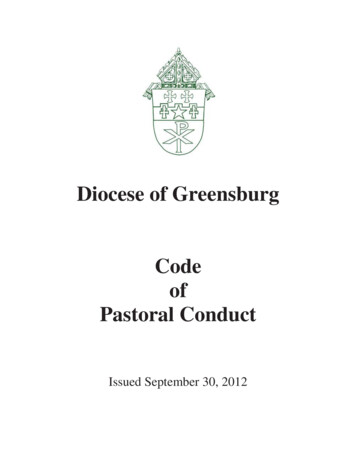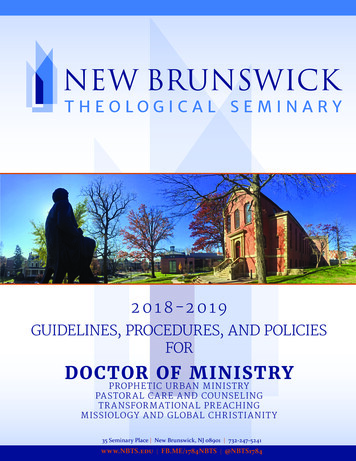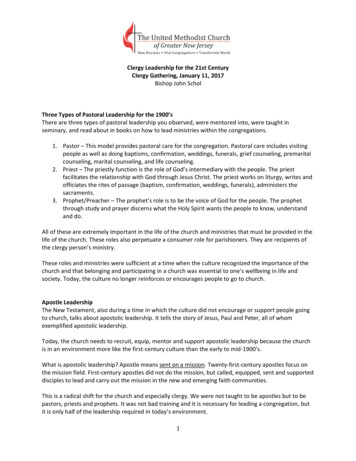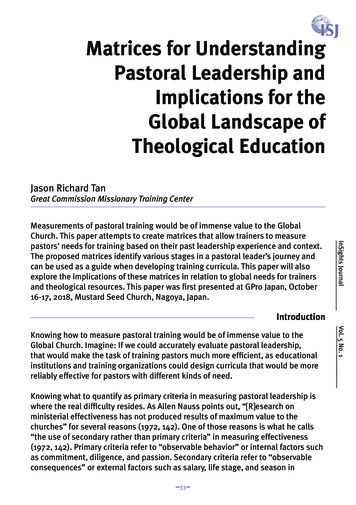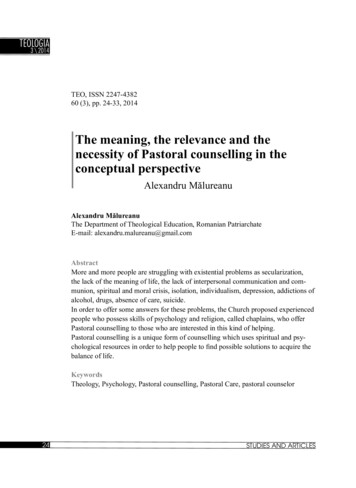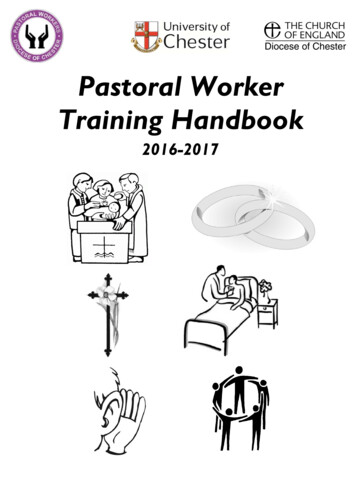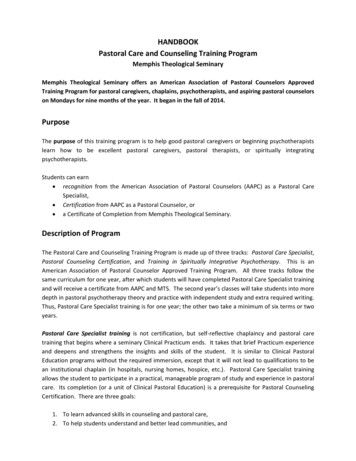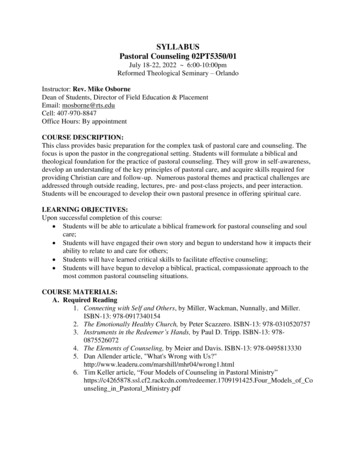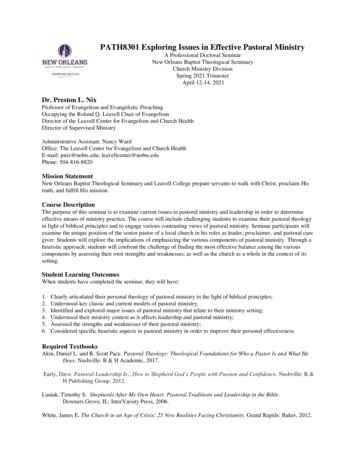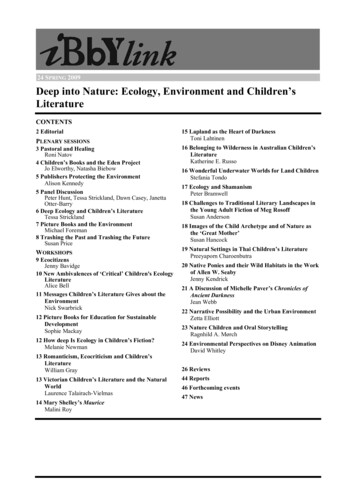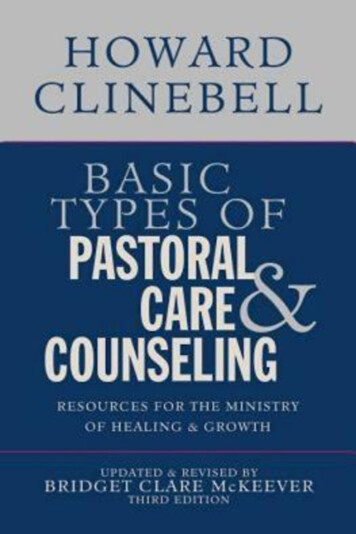
Transcription
ACPP003401QK000.qxp:ACPN005101QT000.qxd11/4/112:53 PMPage iiBASIC TYPES OF PASTORAL CARE & COUNSELINGRESOURCES FOR THE MINISTRY OF HEALING AND GROWTHCopyright 2011 by Abingdon PressAll rights reserved.No part of this work may be reproduced or transmitted in any form or by any means, electronic or mechanical, includingphotocopying and recording, or by any information storage or retrieval system, except as may be expressly permitted by the1976 Copyright Act or in writing from the publisher. Requests for permission can be addressed to Permissions, The UnitedMethodist Publishing House, P.O. Box 801, 201 Eighth Avenue South, Nashville, TN 37202-0801, or e-mailed to permissions@umpublishing.org.This book is printed on acid-free paper.Library of Congress Cataloging-in-Publication DataClinebell, Howard John, 1922Basic types of pastoral care & counseling : resources for the ministry of healing and growth / Howard Clinebell. —Updated and rev. / Bridget Clare McKeever.p. cm.Includes bibliographical references and index.ISBN 978-0-687-66380-4 (trade pbk. : alk. paper)1. Pastoral counseling. 2. Pastoral care. I. McKeever, Bridget Clare. II. Title. III. Title: Basic types of pastoral careand counseling.BV4012.2.C528 2011253.5—dc232011020286Originally published as Basic Types of Pastoral Counseling: New Resources for the Troubled. ISBN 0-687-02491-9, cloth, andISBN 0-687-02490-0, paper.Scripture quotations, unless noted otherwise, are taken from the New Revised Standard Version of the Bible, copyright1989, Division of Christian Education of the National Council of the Churches of Christ in the United States of America.Used by permission. All rights reserved.Scripture quotations marked ESV are from The Holy Bible, English Standard Version , copyright 2001 by CrosswayBibles, a publishing ministry of Good News Publishers. Used by permission. All rights reserved.Scripture quotations marked JBP are taken from The New Testament in Modern English, rev. ed., trans. J. B. Phillips (NewYork: Macmillan, 1972).Scripture quotations marked TLB are taken from The Living Bible 1971. Used by permission of Tyndale House Publishers,Inc., Wheaton, IL 60189. All rights reserved.Scripture quotations marked NIV are taken from the Holy Bible, NEW INTERNATIONAL VERSION . Copyright 1973, 1978, 1984 by International Bible Society. All rights reserved throughout the world. Used by permission ofInternational Bible Society.Scripture quotations marked RSV are taken from the Revised Standard Version of the Bible, copyright 1952 [2nd edition,1971] by the Division of Christian Education of the National Council of the Churches of Christ in the United States ofAmerica. Used by permission. All rights reserved.Scripture quotations marked NEB are taken from The New English Bible. The Delegates of the Oxford University Pressand The Syndics of the Cambridge University Press 1961, 1970. Reprinted by permission.Excepts from Pastoral Care in a Historical Perspective by William R. Clebsch and Charles R. Jaekle ( Jason Aronson, Inc.,a Member of the Rowman & Littlefield Publishing Group) appear by permission.Excerpts from Carmen Knudson-Martin’s article “Spirituality and Gender in Clinical Practice” from Family Therapy News(August-September 2001) appear by permission.Excerpts from Richard Voss’s article “Pastoral Social Ministry in the Ecosystem of the Poor: Breaking through the Illusion”from Journal of Pastoral Care 47 (1993) appear by permission.11 12 13 14 15 16 17 18 19 20—10 9 8 7 6 5 4 3 2 1MANUFACTURED IN THE UNITED STATES OF AMERICA The United Methodist Publishing House. All rights reserved.
ACPP003401QK000.qxp:ACPN005101QT000.qxd11/4/112:53 PMPage iiiCONTENTSPreface by Charlotte Ellen . . . . . . . . . . . . . . . . . . . . . . . . . . . . . . . . . . . . . . . . . . . . . . . . . . . v1. Pastoral Care and Counseling: Challenges and Opportunities . . . . . . . . . . . . . . . . . . . 12. A Model for Spiritually Centered Holistic Pastoral Caregiving . . . . . . . . . . . . . . . . . 213. The History, Mission, and Theological-Biblical Foundations ofPastoral Caregiving . . . . . . . . . . . . . . . . . . . . . . . . . . . . . . . . . . . . . . . . . . . . . . . . . . . . 434. Foundational Skills for Most Types of Caring and Counseling . . . . . . . . . . . . . . . . . . 655. Methods of Holistic Supportive Caregiving . . . . . . . . . . . . . . . . . . . . . . . . . . . . . . . . . 936. Short-term Pastoral Counseling in Crises . . . . . . . . . . . . . . . . . . . . . . . . . . . . . . . . . . 1117. Holistic Caregiving in Challenging Crises . . . . . . . . . . . . . . . . . . . . . . . . . . . . . . . . . 1378. Caregiving in Chronic and Long-term Illness . . . . . . . . . . . . . . . . . . . . . . . . . . . . . . 1639. Bereavement Caregiving: Before, During, and After Losses . . . . . . . . . . . . . . . . . . . 18310. Healing Spiritual Brokenness and Cultivating Spiritual Wholeness inPastoral Care and Counseling . . . . . . . . . . . . . . . . . . . . . . . . . . . . . . . . . . . . . . . . . . . 21311. Ethical, Meaning, and Value Issues in Pastoral Care and Counseling . . . . . . . . . . . . 24312. Crisis Counseling and Enrichment with Couples . . . . . . . . . . . . . . . . . . . . . . . . . . . . 27113. Pastoral Care, Counseling, and Enriching Families . . . . . . . . . . . . . . . . . . . . . . . . . . 31114. Educative Counseling . . . . . . . . . . . . . . . . . . . . . . . . . . . . . . . . . . . . . . . . . . . . . . . . . 34715. Group Pastoral Care and Counseling . . . . . . . . . . . . . . . . . . . . . . . . . . . . . . . . . . . . . 37716. The Art of Referral in Pastoral Caregiving . . . . . . . . . . . . . . . . . . . . . . . . . . . . . . . . 39317. Inclusive Caregiving: Bridging Cultural, Racial, Ethnic, Class, andGender Diversity . . . . . . . . . . . . . . . . . . . . . . . . . . . . . . . . . . . . . . . . . . . . . . . . . . . . . 41318. Equipping Laypersons for Caregiving Ministries . . . . . . . . . . . . . . . . . . . . . . . . . . . . 44119. Self-care for Caregivers . . . . . . . . . . . . . . . . . . . . . . . . . . . . . . . . . . . . . . . . . . . . . . . . 461Notes . . . . . . . . . . . . . . . . . . . . . . . . . . . . . . . . . . . . . . . . . . . . . . . . . . . . . . . . . . . . . . . . . . 479Index . . . . . . . . . . . . . . . . . . . . . . . . . . . . . . . . . . . . . . . . . . . . . . . . . . . . . . . . . . . . . . . . . . 503 The United Methodist Publishing House. All rights reserved.
Basic Types of Pastoral Care & CounselingResources for the Ministry of Healing and GrowthBy Howard ClinebellAbingdon PressCopyright 1984 Abingdon PressAll rights reserved. ISBN: 978-1-4267-5602-3ContentsSOME PERSONAL,REFLECTIONS ABOUT THIS BOOK,Chapter 1 The Present Challenge of Pastoral Care and Counseling,Chapter 2 A Holistic Liberation-Growth Model of Pastoral Care and CouChapter 3 The Mission, Biblical Bases and Uniqueness of Pastoral CareChapter 4 The Foundation of All Types of Caring and Counseling,Chapter 5 Facilitating Spiritual Wholeness: The Heart of Pastoral CarChapter 6 Counseling on Ethical, Value, and Meaning Issues,Chapter 7 Supportive Care and Counseling,Chapter 8 Crisis Care and Counseling,Chapter 9 Bereavement Care and Counseling,Chapter 10 Marriage Enrichment and Marriage Crisis Counseling,Chapter 11 Family Enrichment and Counseling,Chapter 12 Referral Counseling,Chapter 13 Educative Counseling,Chapter 14 Group Care and Counseling,Chapter 15 Pastoral Psychotherapy,Chapter 16 Training Lay Persons for Their Caring Ministries,Chapter 17 How to Keep Your Caring and Counseling Skills Growing,NOTES,INDEX,CHAPTER 1The Present Challenge of Pastoral Care and Counseling
On a dangerous seacoast where shipwrecks often occur there was once a crudelittle lifesaving station. The building was just a hut, and there was only one boat,but the few devoted members kept a constant watch over the sea, and with nothought of themselves went out day and night tirelessly searching for the lost.Many lives were saved by this wonderful little station, so that it became famous.Some of those who were saved, and various others in the surrounding area,wanted to become associated with the station and give of their time and moneyand effort for the support of its work. New boats were bought and new crewstrained. The little lifesaving station grew.Some of the members of the lifesaving station were unhappy that the buildingwas so crude and poorly equipped. They felt that a more comfortable placeshould be provided as the first refuge of those saved from the sea. So theyreplaced the emergency cots with beds and put better furniture in the enlargedbuilding. Now the lifesaving station became a popular gathering place for itsmembers, and they decorated it beautifully and furnished it exquisitely, becausethey used it as a sort of club. Fewer members were now interested in going to seaon lifesaving missions, so they hired lifeboat crews to do this work. The lifesavingmotif still prevailed in this club's decoration, and there was a liturgical lifeboat inthe room where the club initiations were held. About this time a large ship waswrecked off the coast, and the hired crews brought in boatloads of cold, wet, andhalf-drowned people. They were dirty and sick, and some of them had black skinand some had yellow skin. The beautiful new club was in chaos. So the propertycommittee immediately had a shower house built outside the club where victimsof shipwreck could be cleaned up before coming inside.At the next meeting, there was a split in the club membership. Most of themembers wanted to stop the club's lifesaving activities as being unpleasant and ahindrance to the normal social life of the club. Some members insisted uponlifesaving as their primary purpose and pointed out that they were still called alifesaving station. But they were finally voted down and told that if they wantedto save the lives of all the various kinds of people who were shipwrecked in thosewaters, they could begin their own lifesaving station down the coast. They did.As the years went by, the new station experienced the same changes that hadoccurred in the old. It evolved into a club, and yet another lifesaving station wasfounded. History continued to repeat itself, and if you visit that sea coast today,you will find a number of exclusive clubs along that shore. Shipwrecks arefrequent in those waters, but most of the people drown!In this striking parable Theodore Wedel depicts the perennial danger confronting
the church—irrelevance. The peril is especially acute in periods when the churchis outwardly successful. The parable highlights the fact that the only relevancethat really matters is relevance to the deep needs of persons—relevance to theplaces in their lives where they hurt and hope, curse and pray, hunger formeaning and thirst for significant relationships. Pastoral care and counseling arevaluable instruments by which the church stays relevant to human need. They areways of translating the good news into the "language of relationships," as ReuelHowe expresses it—a language which allows the minister to communicate ahealing message to persons struggling in alienation and despair. Pastoralcounseling is an essential means by which a church is helped to be a lifesavingstation and not a club, a hospital and a garden of the spiritual life—not amuseum. Counseling can help save those areas of our lives that are shipwreckedin the storms of our daily living, broken on the hidden reefs of anxiety, guilt, andlack of integrity. An effective caring and counseling program, in which bothminister and trained lay persons serve as enablers of healing and growth, cantransform the interpersonal climate of a congregation, making a church a placewhere wholeness is nurtured in persons throughout the life cycle.Pastoral care and counseling contribute to the continuing renewal of a church'svitality by providing instruments for the renewal of persons, relationships, andgroups. By reducing the crippledness of our ability to give and receive love,counseling can help us to be the church—the community in which God's lovebecomes an experienced reality in relationships. Thus, counseling is aninstrument of continuing renewal through reconciliation, helping to heal ourestrangement from ourselves and our families, from other church members, fromthose outside the church, and from an enlivening, growing relationship with God.It can create windows of new awareness, restoring sight to eyes previouslyblinded by our anxious, guilt- ridden self-concern—to the beauty, tragedy,wonder, and pain all about us. Counseling can allow us to discover freshdimensions of our humanity. It can release our potentialities for authenticity andaliveness. It can help to release our trapped creativity—the potential creativitypresent in every person. By renewing us as persons, counseling helps empower usto become renewal agents in a church and in a society that desperately needrenewing.Pastoral counseling and care can be instruments of healing and growth byhelping us develop what is most difficult to achieve in our period ofhistory—depth relationships. Most of us can identify with the pain of the ministerwho said to his psychotherapist, "My life is characterized by a plethora ofcontacts and a poverty of relationships." This is the common blight that threatensthe creativity of each of us in our touch-and-run culture—a culture oriented
toward interpersonal superficiality. This is the blight that militates against thecontinuing rebirth of a church as a redemptive social organism, preventing itfrom becoming a place where persons experience transformation. This is whatprevents a church from being a lifesaving station engaged in rescuing personsfrom our society's many forms of brokenness.It is far from easy to relate to the depths of other persons. To do so is to comealive to their personhood—to their pain and potential, their emptiness or fullness,their unique blend of hope and despair. It is painful to relate to the depths ofothers because it inevitably exposes us to the dark rooms of our own inner world.Their emptiness reminds us of our own. Their anger and guilt cause ours toresonate. Yet only as we relate to others in depth can we become growthenablers in their lives. Only those who have discovered new life in their owndepths can become spiritual obstetricians, aiding the birth of new life inindividuals and in the church. Pastoral care and counseling can help equip suchobstetricians of the spiritual life, such enablers of the continuing rebirth that isgrowth.When people touched Jesus' life, they experienced in him the healing power thatcomes from openness to oneself, others, nature, and God. They encountered aperson whose life was a deep channel through which the source of all healingand growth—the loving spirit of God—flowed freely and fully.When people touch my life or yours, what do they sense? The noisy static of ourharried times, perhaps? As instruments for deepening and enliveningrelationships, pastoral care and counseling can help bring continuing renewal tous as ministers and to persons in the church and in the community! Such renewalcomes as a refreshing rain to a parched land.The Contemporary RenaissanceIn each period of history and every new environment, the church must find freshways of meeting the needs of troubled persons—new channels for its centuryspanning ministry of caring, healing, and growth. Only thus can it remain relevantto the deep needs of people. The varied methods of pastoral care and counselingoffer a widening channel of healing and growth in our period of church history.One hopeful sign on the contemporary religious scene is the rising wave ofactivity in the field of pastoral counseling. Since World War II a surge of lively
interest has been evident in the field. The ministry of counseling has beenflowering with increasing vigor. Some of the signs of a remarkable vitality are: thegrowing availability and impact of clinical pastoral education, the strengtheningof seminary education in counseling, the remarkable proliferation of churchrelated counseling programs, the emergence of pastoral counseling as arigorously trained specialty within the ministry, the establishment of seminarygraduate programs in pastoral psychology and counseling, the rise of theAmerican Association of Pastoral Counselors, the burgeoning literature in thefield, the commitment to restoring the spiritual and theological center of thispastoral art, denominational counseling programs, the current experimentation inthe pastoral care ministry of the laity, the increasing number of women and theimpact of feminist thought in the field, the growth of intercultural and globalcross-fertilization in the field. It is thrilling to realize that we are in a renaissanceperiod in the church's age-old ministry to the burdened. The challenge to each ofus is to become a participant and contributor, not a mere observer, in thisdynamic movement—a movement that provides fresh responses to the needs ofthose lying beside our modern Jericho roads, robbed of their self-esteem andbeaten by the crises and tragedies of life.If the pastoral care and counseling renaissance is to become the powerful forcefor growth and renewal that it can become in the eighties and nineties, certaindecisive changes must occur. Pastoral counseling must find a new level of selfidentity and maturity by deepening its theological roots, broadening itsmethodology, and discovering its unique contribution to the helping of troubledhumanity, with reference to both its own heritage and the other helpingdisciplines. The minister as counselor needs a unique self-understanding of her orhis image, role, functions, and goals. A minister's self-understanding must have atheological base derived from awareness of the grounding of what one does inthe ongoing message, community, and tradition of the church. Majorcontributions have been made to this theological self-understanding in recentliterature. The thrust of this book is toward broadening the methodology andenriching the guiding model of pastoral care and counseling.A new chapter in the church's ministry to the heavy-laden is now possible. It canbe a chapter without equal in the history of our faith. Never before have we hadsuch rich resources as are provided by fresh developments in theology and inpastoral care, by fresh insights from the human sciences, and by innovativetechniques from the psychotherapeutic disciplines. When these three streamsconverge in the pastoral care ministry, a broad river of healing and growth isreleased through a church. To cooperate with this powerful movement of the lifetransforming spirit of God in our times should command our most disciplined
self-investment. I hope the ideas and approaches described in this book willcontribute toward this objective.The Purposes of this BookThe primary objective of this book is to help ministers (and seminary students)develop maximum skills in the basic caring and counseling methods required for aneffective ministry of healing and growth. Subsumed under this generic objectiveare more specific purposes: (1) It is a purpose of this book to describe a newholistic growth and liberation centered paradigm for pastoral care and liberationcounseling with spiritual and ethical wholeness at its center (chapters 2, 5, & 6).This guiding image is essentially multidimensional, focusing on the growth ofwhole-persons-in their-relationships. It seeks to integrate intrapsychic andinterpersonal healing and growth with constructive change in the widerstructures and institutions of people's lives. This paradigm (which builds on myearlier revised model) offers a conceptual basis for integrating the other functionsof ministry with pastoral care— preaching, leading worship, church management,teaching, facilitating small groups, serving the community, and working to makeinstitutions more growth-enabling. The paradigm distinguishes and shows theinterdependence of pastoral care and pastoral counseling.(2) It is a purpose of this book to overview the mission, theological foundations,historical heritage, and uniqueness of pastoral care and counseling (chapter 3).(3) It is a purpose of this book to review the fundamental procedures to all caringand counseling (chapter 4). These basic procedures provide a foundation for theuse of the methodologies described in subsequent chapters.(4) It is a purpose of this book to set forth a differential typology of pastoral careand counseling as a way of understanding the full range of a minister'sopportunities to facilitate healing and growth. Pastoral care and counseling arenot one entity with one methodology. Instead they are a wide range of helpingand growthing functions requiring a variety of methods. To respond to the variedneeds of those who seek help, a pastor must be able to shift gears in caring andcounseling—to utilize approaches appropriate to the particular resources andproblems, strengths and limitations of each person. Pastors must be able toutilize different facets of their own personalities freely and flexibly. With personsfloundering in catastrophic crises, for example, pastors need to use theirsupportive, caring "Parent" side to give such persons stability in coping with
enormously stressful situations. To help persons who have never achievedconstructive inner values or controls to guide their lives, the minister must be afirm, accepting, but not a permissive parent figure. In contrast, counselees withrigid, punitive consciences need to experience a minister's more self-accepting,grace-full and playful side. It is not that a minister puts on a varied act in eachcase. To do so would destroy the interpersonal integrity that creates effectivecounseling. Rather, the pastor employs different dimensions of his or hermultifaceted personality, responding to the varying needs of different counselees.It should be made clear that different counseling methods often are employed atvarious stages of a counseling relationship, sometimes during the same session.Just as a carpenter needs a variety of tools to build a fine piece of furniture, acounselor requires a variety of methods to help persons rebuild a marriage or adestructive value structure. As experienced pastors know, the varied counselingand caring opportunities that confront them require both flexibility and ingenuityin applying everthing they know about persons and about counseling. What theyhave learned from their own growth struggles is often more useful thansophisticated knowledge of counseling techniques. But the more counselorsknow about counseling theories and methods, the better use they can make oftheir unique life experiences and personality resources. It is the intent of thisbook to encourage readers to increase their versatility and effectiveness bydeveloping their own differential approaches to caring and counseling.(5) It is a further purpose of this book to highlight those types of caring andcounseling that are essential and therefore normative in a persons-centered,general (nonspecialists) ministry: shortterm crisis help (chapters 7 and 8); griefrelated caring and counseling (chapter 9); marriage and family enrichment andcounselings (chapters 10 and 11); referral counseling (chapter 12); educative andsmall group counseling (chapters 13 and 14); and training lay caring teams(chapter 16). These types constitute the heart of a parish minister's caring andcounseling. Most persons in general ministries do not have the time, even if theyhave the required training, to do long-term, reconstructive pastoralpsychotherapy. This type of healing work is primarily the function of those inspecialized ministries of counseling who have graduate academic and clinicaleducation in psychotherapy in addition to seminary. The chapter on pastoralpsychotherapy (chapter 15) aims at describing what persons in general ministriesneed to know in order to recognize those needing referrals to specialists andprovide appropriate pastoral care while parishioners are experiencing this type ofdepth therapy. This chapter also points to some newer therapies that provideinsights and methods useful in a generalist ministry. Ours is a period of amazingfecundity in the field of psychotherapy. We in the church must experiment with
fresh approaches as we search for resources to enhance our effectiveness in theministry of caring and counseling.(Continues.)Excerpted from Basic Types of Pastoral Care & Counseling by HowardClinebell. Copyright 1984 Abingdon Press. Excerpted by permission ofAbingdon Press.All rights reserved. No part of this excerpt may be reproduced orreprinted without permission in writing from the publisher.Excerpts are provided by Dial-A-Book Inc. solely for the personal use ofvisitors to this web site.
Learn the foundational skills, models, and concepts of pastoral care and counseling.Basic Types of Pastoral Care and Counseling remains the standard in pastoral careand counseling. This third edition is enlarged and revised with updated resources,methods, exercises, and illustrations from actual counseling sessions. It will helpreaders be sensitive to cultural diversity, ethical issues, and power dynamics as theypractice holistic, growth-oriented pastoral care and counseling in the parish.Basic Types of Pastoral Care and Counseling is as timeless as any great work of art. Once again,Clinebell offers a resource for renaissance in the field of pastoral care and counseling. This third,revised edition contains depth perspectives on gender, race, class, and ethnicity as well as boldstrokes of self-care for caregivers. Clinebell offers a creative canvas of holistic caregiving and assuch, his magnum opus.—Jeanne Stevenson-Moessner, Perkins School of Theology, Southern Methodist UniversityThis updated and comprehensive version offers significant postmodern and inclusiveperspectives that build on the legacy of Clinebell’s earlier work. It is a significant contributionto the field of pastoral care and counseling and ought to be read by laypersons and clergy inministry who seek to offer healing and wholeness.—Joretta Marshall, Texas Christian UniversityHoward Clinebell, formerly professor of pastoral psychology and counseling at theSchool of Theology, Claremont, California, was an author and world authority in careand counseling.Bridget Clare McKeever, SSL, Ph.D. is a Sister of St. Louis; spiritual and retreatdirector; author; and pastoral care editor of Gleanings. She is also a former studentof Howard Clinebell.
1. Pastoral counseling. 2. Pastoral care. I. McKeever, Bridget Clare. II. Title. III. Title: Basic types of pastoral care and counseling. BV4012.2.C528 2011 253.5—dc23 2011020286 Originally published as Basic Types of Pastoral Counseling: New Resources for the Troubled. ISBN -687-02491-9, cloth, and ISBN -687-02490-0, paper.
